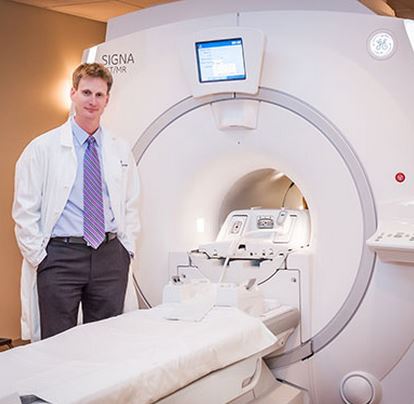Simultaneous Scanning: Improving Image Quality and Allowing Better Informed Decisions

The PET/MRI, a recently-developed hybrid imaging modality, offers the convenience of two scans, the PET and the MRI, in one. The benefits reach far beyond convenience and reduced radiation. In combination, the two modalities improve patient care by minimizing radiation doses while also providing more accurate images and information.
Dr. Thomas Hope, chief investigator of MRI and assistant professor in residence in the Department of Abdominal Imaging and Nuclear Medicine at UCSF and the San Francisco Veterans Affairs Medical Center, said a common patient concern is the physical consequences of radiation. Although the risk is not fully understood, it is believed that cumulative radiation patients receive over the course of numerous imaging studies may be associated with the development of secondary cancers. Among patients who may be especially vulnerable to the effects of cumulative radiation are those with pediatric lymphoma or coronary artery disease. With new developments such as the PET/MRI, however, Dr. Hope said, “Patients can be administered radiation at a fraction of what they are today because the ionization radiation from CT has been replaced with MRI, which exposes patients to zero radiation. Minimizing radiation during the procedure in this manner reduces the risk of developing future cancers.”
In addition to minimizing radiation dose, UCSF is focusing on how to leverage the simultaneous acquisition of information beyond usual applications. “It’s not about equivalence. We’re trying to do something better. We don’t schedule a PET/MRI scan merely because it is more convenient. When used properly, PET/MRI can provide better images than a sequential PET scan and an MRI scan. We provide our patients and their referring physicians with a better characterization of the illness, so they can make the best decision possible for their health.”
Thomas Hope, MD, is an assistant professor in residence in the Abdominal Imaging and Nuclear Medicine sections at UCSF and the San Francisco Veterans Affairs Medical Center. In 2007, he received his medical degree from Stanford University School of Medicine and he completed a one-year internship at Kaiser Permanente, San Francisco. From 2008-2012, Dr. Hope completed a residency in Diagnostic Radiology at the University of California, San Francisco, followed by a clinical fellowship in Body MRI and Nuclear Medicine from Stanford Medical Center in 2013.
